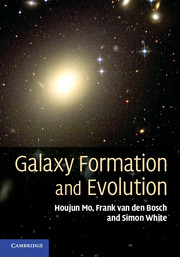Book contents
- Frontmatter
- Contents
- Preface
- 1 Introduction
- 2 Observational Facts
- 3 Cosmological Background
- 4 Cosmological Perturbations
- 5 Gravitational Collapse and Collisionless Dynamics
- 6 Probing the Cosmic Density Field
- 7 Formation and Structure of Dark Matter Halos
- 8 Formation and Evolution of Gaseous Halos
- 9 Star Formation in Galaxies
- 10 Stellar Populations and Chemical Evolution
- 11 Disk Galaxies
- 12 Galaxy Interactions and Transformations
- 13 Elliptical Galaxies
- 14 Active Galaxies
- 15 Statistical Properties of the Galaxy Population
- 16 The Intergalactic Medium
- A Basics of General Relativity
- B Gas and Radiative Processes
- C Numerical Simulations
- D Frequently Used Abbreviations
- E Useful Numbers
- References
- Index
10 - Stellar Populations and Chemical Evolution
Published online by Cambridge University Press: 05 June 2012
- Frontmatter
- Contents
- Preface
- 1 Introduction
- 2 Observational Facts
- 3 Cosmological Background
- 4 Cosmological Perturbations
- 5 Gravitational Collapse and Collisionless Dynamics
- 6 Probing the Cosmic Density Field
- 7 Formation and Structure of Dark Matter Halos
- 8 Formation and Evolution of Gaseous Halos
- 9 Star Formation in Galaxies
- 10 Stellar Populations and Chemical Evolution
- 11 Disk Galaxies
- 12 Galaxy Interactions and Transformations
- 13 Elliptical Galaxies
- 14 Active Galaxies
- 15 Statistical Properties of the Galaxy Population
- 16 The Intergalactic Medium
- A Basics of General Relativity
- B Gas and Radiative Processes
- C Numerical Simulations
- D Frequently Used Abbreviations
- E Useful Numbers
- References
- Index
Summary
Following up on the previous chapter, in which we discussed star formation, we now address how individual stars evolve with time. As we will see below, most stars, during most of their evolutionary histories, can be considered as spherically symmetric objects with a constant mass that are in hydrostatic equilibrium. Under these conditions, the evolution of a star is almost completely determined by its mass and chemical composition through a set of ordinary differential equations that describe the structure of the star. In this chapter, we start with a brief description of the basic concepts of the theory of stellar evolution. A detailed description is beyond the scope of this book, but can be found in many monographs and textbooks on this subject (e.g. Schwarzschild, 1965; Clayton, 1983; Kippenhahn & Weigert, 1990). We then use the theory of stellar evolution to predict the properties of individual stars (e.g. spectrum, luminosity, metal production, etc.) at different evolutionary stages, and discuss how these results can be synthesized to make predictions regarding the evolution of populations of stars (e.g. galaxies). Finally, we discuss how the evolution of stars affects the chemical evolution of galaxies.
The Basic Concepts of Stellar Evolution
A stellar evolution model generally starts with two basic assumptions: (i) stars are in hydrostatic equilibrium, and (ii) stars are spherically symmetric.
- Type
- Chapter
- Information
- Galaxy Formation and Evolution , pp. 449 - 494Publisher: Cambridge University PressPrint publication year: 2010



